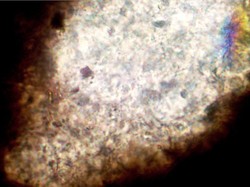 India Ink Slide with excessive EPS
India Ink Slide with excessive EPS First, viscous bulking is caused when bacteria begin to produce excessive amounts of extracellular polysaccharides (EPS). When in normal concentrations EPS acts like a glue to increase floc size and density, excess EPS can entrap water and form a "gel" like floc that is easily suspended by water currents. (The floc bulk density is nearing that of water). At this point the suspended floc goes over the clarifier weir, can cause problems with polymer demand, increase water in wasted sludge, and cause problems maintaining permit. In addition to holding additional water in the floc, the EPS can also have an abnormal charge density that changes polymer demand.
How to test for viscous bulking:
- Visual - notice billowing floc in clarifier
- Microscopic exam - operators notice rounded floc with sections appearing "gel" like
- Use India Ink - a drop of India Ink on the microscopic exam slide will give a good estimate of bulking. The India Ink will penetrate normal floc turning it dark. Excessive EPS remains clear or light gray as the ink does not penetrate the EPS gel.
- SV30 - often viscous bulking appears as a "greasy" or slimey floc.
- Usually caused by a nutrient deficiency - either nitrogen or phosphorus check residuals at effluent
- Can also be caused by certain influents such as high FOG, toxic compounds, or high levels of easily soluble organics such as alcohols or sugars.
Solutions:
- Wasting - once floc exhibits viscous bulking it does not go back to normal under wastewater system conditions. It is necessary to waste most of excessive EPS floc form the system.
- Add nutrients - it is critical to increase nutrients to an ideal range. Often in industrial wastewater it is critical to add additional phosphate.
- While wasting and increasing nutrient feed, we often find it highly beneficial to add microbes (bioaugmentation) cultures. This has the advantage over trucking in sludge as it contains only active microbes which work within existing biomass to control the excessive EPS production and restore the system to normal efficiency.

 RSS Feed
RSS Feed